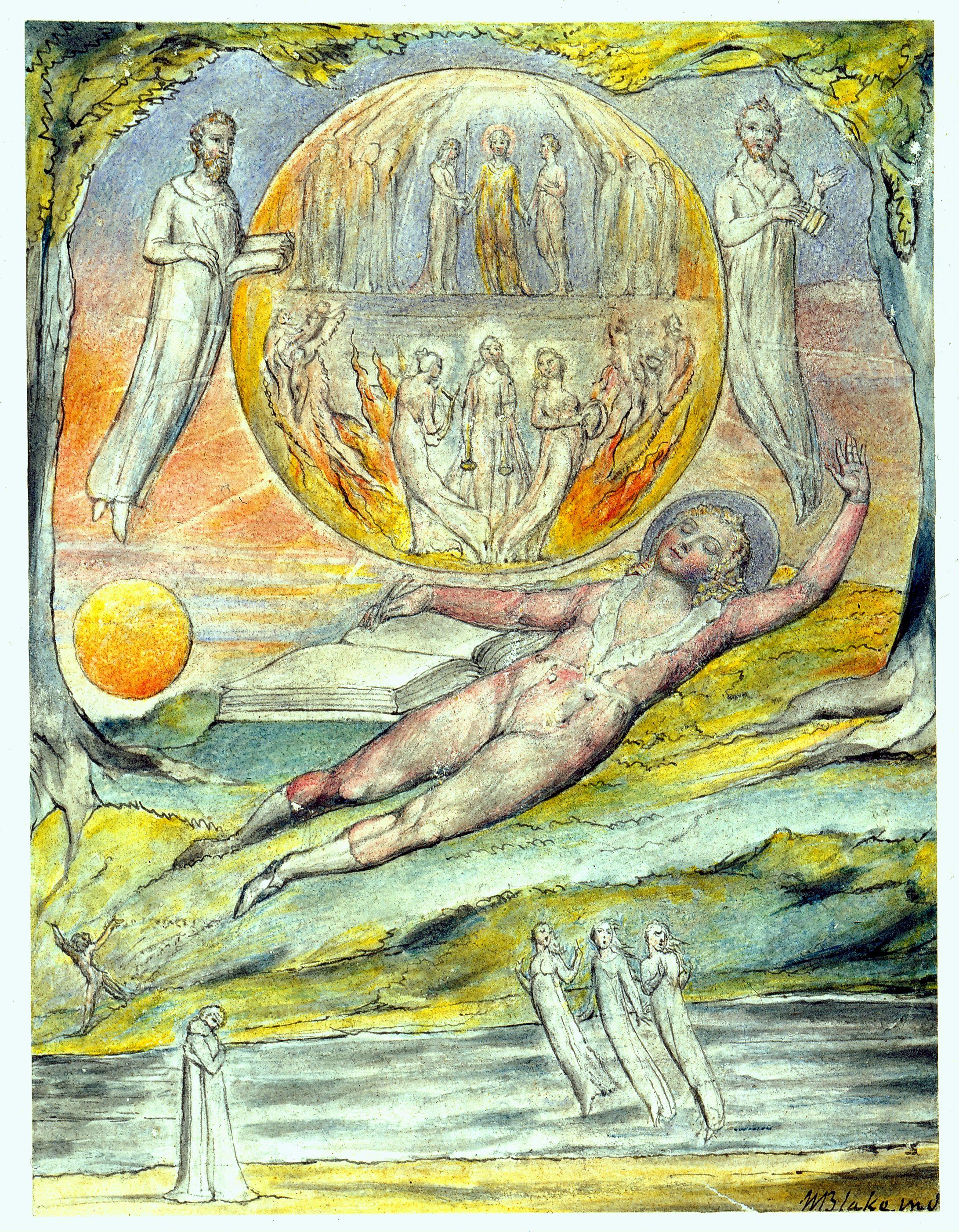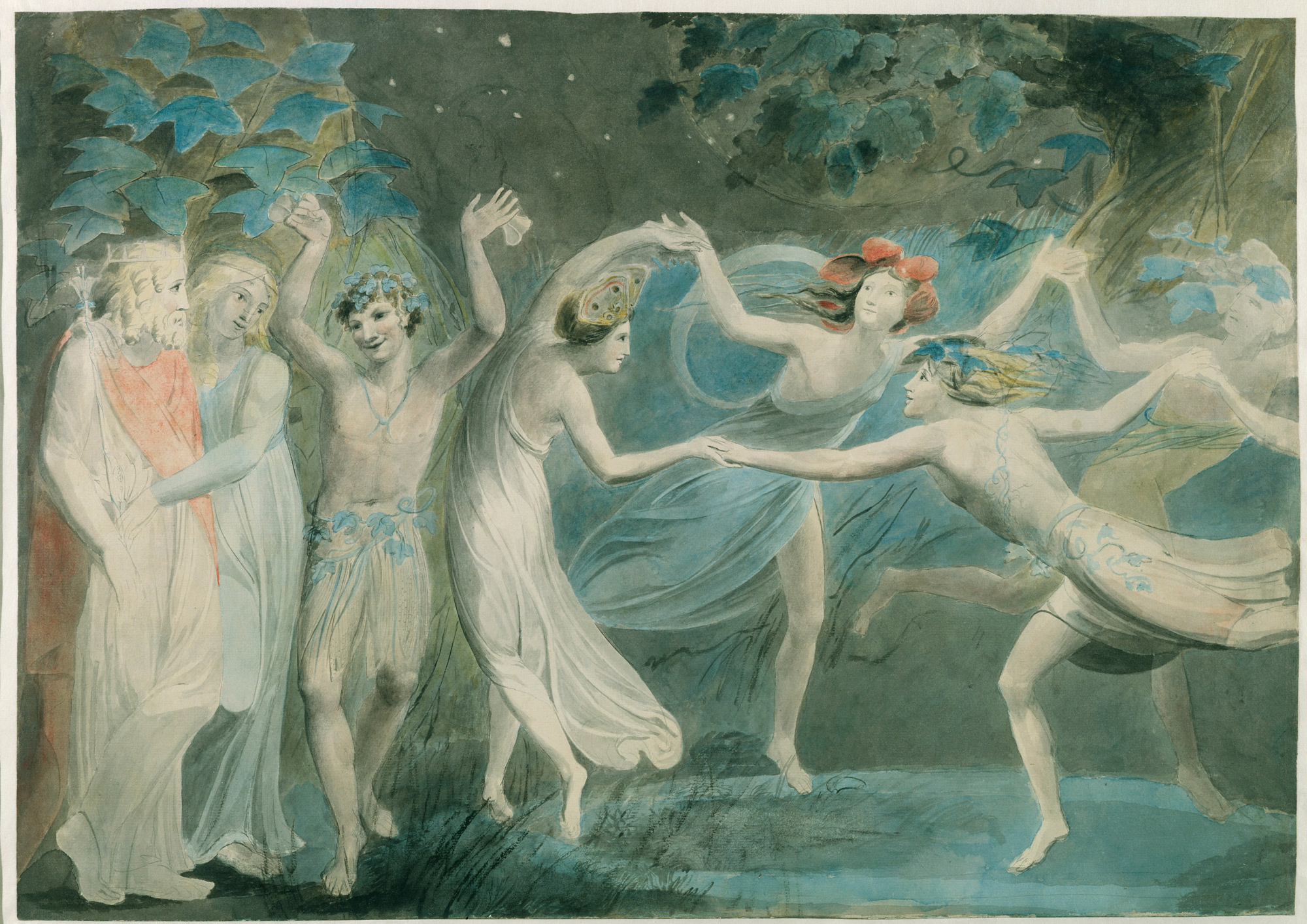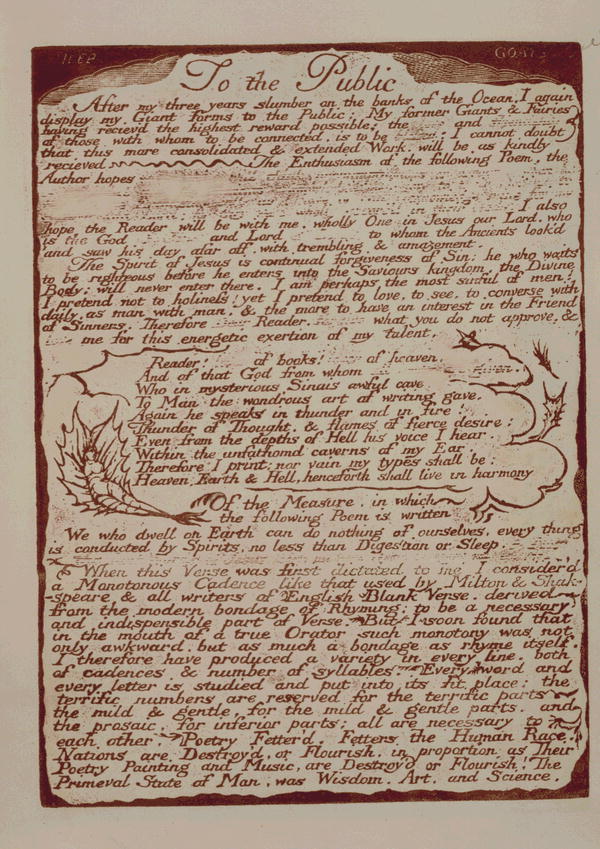Blake's picture (below) which goes both by the names Hecate and The Night of Enitharmon's Joy is one of his Large Color Printed Drawings of 1795. There are reasons why the picture came to be called by different names. Blake would have been familiar with Hecate's role in ancient mythology and with the instances in which she appears in Shakespeare's Macbeth and Midsummer Night's Dream. The central figure is pictured threefold as the goddess Hecate was imagined by the Greeks, but for Blake she includes a young male and a young female with the central woman. She is beautiful as Blake said the the witches in Shakespeare should be represented.
"By way of illustration, I instance Shakspeare's Witches in
Macbeth. Those who dress them for the stage, consider
them as wretched old women, and not as Shakspeare intended, the
Goddesses of Destiny; this shews how Chaucer has been
misunderstood in his sublime work. Shakspeare's Fairies also
are the rulers of the vegetable world, and so are Chaucer's;
let them be so considered, and then the poet will be understood,
and not else."
(Descriptive Catalogue, p16; E535)
"By way of illustration, I instance Shakspeare's Witches in
Macbeth. Those who dress them for the stage, consider
them as wretched old women, and not as Shakspeare intended, the
Goddesses of Destiny; this shews how Chaucer has been
misunderstood in his sublime work. Shakspeare's Fairies also
are the rulers of the vegetable world, and so are Chaucer's;
let them be so considered, and then the poet will be understood,
and not else."
(Descriptive Catalogue, p16; E535)
***************************************************************************************
On pages 482-4 Blake wrote "Descriptions to Illustrations to Milton's Allegro and II Penseroso"; it appears that Shakespeare appears incidentally in this
Section.
MILTON'S L'ALLEGRO VI
In his manuscript notes accompanying his watercolors Blake singles out these verses from Milton for his sixth illustration to L'Allegro:
Descriptions of Illustrations to Milton's L'Allegro and Il Penseroso (E 682)
 "There let Hymen oft appear
"There let Hymen oft appear
 "There let Hymen oft appear
"There let Hymen oft appear
In Saffron Robe with Taper clear
With Mask & Antique Pageantry
Such sights as Youthful Poets dream
On Summers Eve by haunted Stream
Then lo the well trod Stage anon
If Johnsons learned Sock be on
Or Sweetest Shakespeare Fancys Child
Warble his native wood notes wild"
Blake wrote:
Blake wrote:
"The youthful Poet sleeping on a bank by the Haunted Stream by Sun Set sees in his Dream the more bright Sun of Imagination. under the auspices of Shakespeare & Johnson. in which is Hymen at a Marriage & the Antique Pageantry attending it."
MiltonMirth6; E684
The youthful poet had entered a dream state which offered a pleasant interlude from the cares of the world. He visited with some of the sources of his inspiration: Shakespeare & Johnson are adjacent to the great sun but not within it.
The sun of imagination was welcomed by both Milton and Blake when it generated the flow of ideas and words. Enclosed in the Sun of Imagination are pictured two levels. The upper portrays a marriage with Hymen, the god of Marriage, officiating. He wears the 'saffron robe' and carries the the 'candle clear' although it appears to be unlighted. His function is to join the contraries into a new being.
At the lower fiery level of the great sun are three women, perhaps muses, with lyre, flute and tambourine. The instruments, however, seem to be silenced since there is no movement of the dance pictured. There are other negative indicators pictured including: enclosing trees, a man running away, three women expressing alarm, the setting of the natural sun, and a man and woman in mournful embrace. Nevertheless the youthful poet seems satisfied to have his pen in his hand and his book at the ready for recording his inspired words.
What Milton has been seeking through mirth in L'Allegro has been finding a mental state in which he may be 'Married to immortal verse/Such as the meeting soul may pierce.' He turns next to Il'Peneroso to seek a melancholy avenue to achieve his poetic goals. Blake's final illustration to L'Allegro stresses the contributions of the lighthearted, extraverted mental approach to the life of the poet. The final two lines of L'Allegro are 'These delights, it thou canst give, Mirth with thee, I mean to live.' But Blake points out what Milton himself knew: that there are shortcomings to the mirthful approach including perhaps the detatched, dreamlike state experienced by Thel in the beginning of the book that bears her name.
"Such a cultural revolution would absorb not only the Classical but all other cultures into a single visionary synthesis, deepen and broaden the public response to art, deliver the artist from the bondage of a dingy and nervous naturalism called, in a term which is a little masterpiece of question-begging, 'realism', and restore him to him the catholicity of outlook that Montaigne and Shakespeare possessed. And though that one religion would be, as far as Blake is concerned, Christianity, it would be a Christianity equated with the broadest possible vision of life...
****************************************************************************************************
Descriptive Catalogue, (E 535)
She is accompanied by the bat, the snake and the owl which are associated with Hecate as a goddess of the night and the underworld. Since the donkey is not generally associated with Hecate its presence is a reference to Titania, Queen of the fairies, who in Midsummer Night's Dream under a spell, falls in love with a man with the appearance of a donkey. This reference would indicate the foolishness of the male submitting to female dominance.








